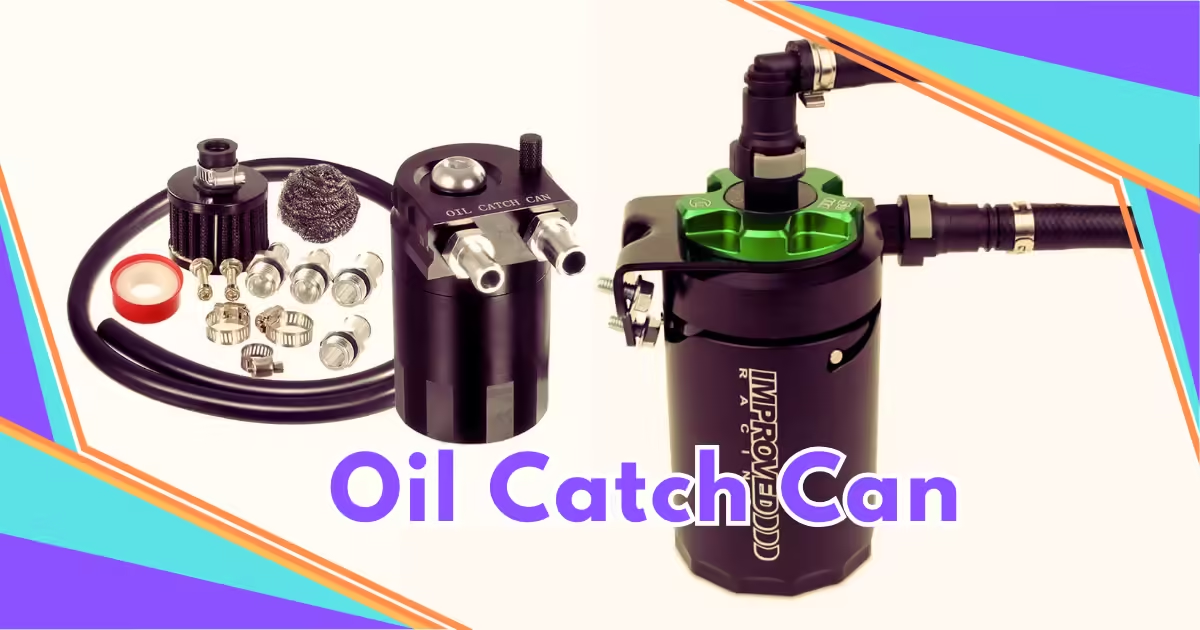An oil catch can is an essential aftermarket device designed to capture oil, moisture, and other contaminants that would otherwise re-enter your vehicle’s intake system. Over time, these particles can accumulate in the engine, leading to reduced performance, increased carbon buildup, and potential damage to internal components.
Placed between the crankcase and the intake manifold, the oil catch can helps keep your engine cleaner and more efficient. This is especially crucial for turbocharged engines, which are more prone to blow-by – the process where air-fuel mixtures leak past the piston rings and introduce contaminants into the engine’s intake system.
Whether you’re a performance enthusiast or just looking to extend the life of your engine, an oil catch can is a valuable addition to your vehicle.
2. How Does This Device Work in Your Engine?
Understanding how this product works is essential for grasping its importance. The crankcase ventilation system in a vehicle is responsible for removing excess gases and pressure from the engine’s crankcase. In the process, oil vapors and other contaminants are carried along with the gases and re-routed back into the intake system.
This product intercepts these gases before they reach the intake, allowing the oil and other particulates to condense and be collected in the can. Clean air is then sent back into the engine’s intake manifold, reducing the buildup of sludge and carbon on valves, pistons, and other critical components.
This process ensures that the engine runs cleaner, which translates to better performance and longevity. It’s an especially useful upgrade for turbocharged and high-performance engines that generate more blow-by gases.
3. The Benefits of Installing an Oil Catch Can
There are several benefits of installing an oil catch can in your vehicle, particularly if you’re concerned about engine performance and maintenance. Some of the key advantages include:
- Reduces carbon buildup: An oil catch can prevents oil vapors from contaminating the intake valves and causing carbon buildup, especially in direct injection engines.
- Improves engine performance: By keeping the intake system cleaner, the engine can operate more efficiently, resulting in improved power output and fuel economy.
- Extends engine life: Cleaner engines are less prone to wear and tear, which means an oil catch can can help prolong the lifespan of your engine.
- Prevents oil pooling: In some cases, blow-by gases can lead to oil pooling in the intake manifold, causing damage or engine misfires. An oil catch can prevents this issue.
- Cost-effective maintenance: Installing an oil catch can is a relatively inexpensive upgrade that can save you money on costly engine repairs down the line.
These benefits make the oil catch can a must-have for those looking to protect their engine and maintain peak performance.
4. Oil Catch Can vs. No Oil Catch Can: Why It Matters
If you’re wondering whether to install an oil catch can or not, consider the differences between engines with and without one. Vehicles without an oil catch can are more likely to experience:
- Increased carbon buildup: Over time, oil vapors will accumulate in the intake system, causing carbon deposits to form on intake valves. This is particularly problematic in direct injection engines where fuel doesn’t pass over the valves to clean them.
- Reduced performance: As carbon deposits build up, they restrict airflow, reduce fuel efficiency, and lead to sluggish engine performance.
- More frequent maintenance: Engines without oil catch cans may require more frequent cleanings or repairs to address issues related to carbon buildup and oil contamination.
In contrast, engines equipped with an oil catch can run cleaner, experience fewer problems, and often deliver better performance over time.
5. How to Install an Oil Catch Can: A Step-by-Step Guide
Installing an oil catcInstalling this product can be a straightforward process if you follow the right steps. Here’s a basic step-by-step guide to help you install one in your vehicle:
- Choose the right product: Make sure to select one that fits your engine and meets your specific needs.
- Gather your tools: You’ll need basic tools such as a socket wrench, hose clamps, and a screwdriver to complete the installation.
- Locate the PCV hose: The product is installed between the PCV (Positive Crankcase Ventilation) valve and the intake manifold. Locate the PCV hose in your engine bay.
- Remove the PCV hose: Carefully disconnect the PCV hose from both ends (the intake manifold and the crankcase).
- Mount the device: Securely mount the product in your engine bay using the provided bracket.
- Connect the hoses: Attach one hose from the crankcase to the product and another from the device to the intake manifold. Use hose clamps to ensure a tight fit.
- Secure everything: Double-check all connections and make sure the product is securely mounted and the hoses are properly clamped.
- Check for leaks: After installation, start the engine and check for any leaks or loose fittings.
By following these steps, you can ensure the product is installed correctly and functioning as intended.
6. Oil Catch Can Maintenance: Tips for Optimal Performance
While an oil catch can is a low-maintenance device, regular checks are essential to keep it performing optimally. Here are some maintenance tips:
- Check the catch can regularly: Depending on your driving habits, you should check the catch can every 1,000 to 3,000 miles to see how much oil has been collected.
- Empty the catch can: Once the catch can is about halfway full, it’s time to empty it. Simply unscrew the bottom of the can and dispose of the oil properly.
- Inspect hoses and connections: Ensure that all hoses are still securely connected and that there are no leaks or cracks in the system.
- Clean the catch can: Over time, residue can build up inside the can. It’s a good idea to clean it thoroughly with brake cleaner or another solvent during each oil change.
Proper oil catch can maintenance will ensure that it continues to keep your engine clean and running efficiently.
7. Top Products for 2024: Best Units Reviewed
Choosing the best product for your vehicle can be overwhelming with so many options available. Here are the top-rated ones for 2024:
- Mishimoto – Known for its durability and efficiency, this is a popular choice among performance enthusiasts.
- Elite Engineering – With a sleek design and excellent filtration, it offers superior oil separation and easy installation.
- Ruien Universal – This affordable option provides great value, featuring a compact design and efficient oil capture for most vehicles.
- JLT Performance – Specifically designed for Ford and GM vehicles, this model offers exceptional performance in reducing blow-by.
- Radium Engineering – A premium product with high-quality construction and advanced oil separation technology.
Each of these offers excellent oil separation and durability, ensuring your engine stays clean and efficient.
8. Common Problems and Fixes
While these devices are generally reliable, a few common issues may arise:
- Leaking hoses: Over time, hoses may loosen or crack, leading to leaks. To fix this, check the connections and replace any worn hoses or fittings.
- Overflowing unit: If it isn’t emptied regularly, it can overflow, leading to oil entering the intake system. Be sure to check and empty it frequently.
- Improper installation: Incorrect installation can lead to poor performance or no oil separation at all. Double-check that all hoses are connected correctly and that it is properly mounted.
Addressing these common problems ensures that the device functions effectively.
9. Why You Need an Oil Catch Can for Your Turbo Engine
For turbocharged engines, the installation of an oil catch can is particularly important. Turbo engines produce higher levels of blow-by gases due to increased pressure, leading to more oil vapor and contaminants entering the intake system.
By installing an oil catch can in a turbo engine, you can prevent carbon buildup, reduce engine wear, and maintain peak performance. This is especially critical for high-performance vehicles where the engine is pushed to its limits.
In addition to keeping your turbocharged engine cleaner, it also helps improve fuel efficiency and throttle response, making it a must-have upgrade for turbo vehicles.
10. Frequently Asked Questions (FAQs) About Oil Catch Cans
- What is an oil catch can?
An oil catch can is a device that collects oil and contaminants from the crankcase ventilation system, preventing them from entering the intake manifold. - Do oil catch cans really work?
Yes, they are highly effective at reducing carbon buildup and improving engine performance, especially in high-performance and turbocharged vehicles. - How often should I empty my oil catch can?
You should check and empty it every 1,000 to 3,000 miles, depending on your driving conditions. - Is installing an oil catch can difficult?
No, installing it is relatively simple and can be done with basic tools. Many kits come with detailed instructions for DIY installation. - Can an oil catch can improve fuel efficiency?
Yes, by keeping the intake system clean, it can help improve fuel efficiency and overall engine performance. - Are oil catch cans necessary for all vehicles?
While not essential for every vehicle, they are highly recommended for turbocharged and direct injection engines that are prone to carbon buildup. - What’s the difference between an oil catch can and an air-oil separator?
A catch can collects oil and contaminants in a container, while an air-oil separator removes oil from the airflow and sends it back to the crankcase. - How much does an oil catch can cost?
Prices range from $30 to $200, depending on the brand and features. - Will installing an oil catch can void my warranty?
It’s best to check with your vehicle’s manufacturer, but in most cases, installing one will not void the warranty. - Can I install an oil catch can myself?
Yes, many of these devices come with DIY installation instructions, making it easy to install at home.
Conclusion
Installing an oil catch can is one of the best investments you can make for your vehicle, especially if you have a turbocharged or high-performance engine. By capturing harmful oil vapors and contaminants before they enter the intake system, an oil catch can improves engine performance, reduces carbon buildup, and extends the life of your engine. Whether you’re a DIY enthusiast or looking for professional installation, choosing the right device can and maintaining it regularly will ensure your vehicle runs cleaner and more efficiently.
Want more fascinating stories and exclusive insights? Visit our homepage to explore a world of captivating content!
Emma Rose is a professional writer with over 3 years of experience covering a wide range of topics, including health, lifestyle, and technology. She is known for her in-depth research and commitment to providing accurate, trustworthy, and engaging content. Emma’s work focuses on delivering value to readers by simplifying complex topics and ensuring every article meets high editorial standards.




